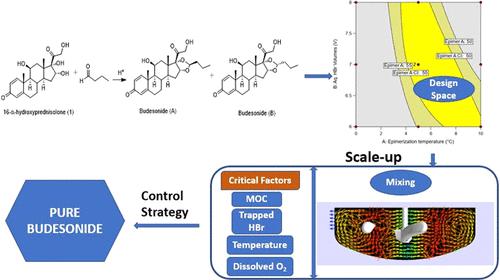当前位置:
X-MOL 学术
›
Org. Process Res. Dev.
›
论文详情
Our official English website, www.x-mol.net, welcomes your
feedback! (Note: you will need to create a separate account there.)
Utilization of Quality by Design, Kinetic Modeling, and Computational Fluid Dynamics for Process Optimization and Scale-Up
Organic Process Research & Development ( IF 3.1 ) Pub Date : 2023-04-17 , DOI: 10.1021/acs.oprd.3c00015 Venkata Ramana Kandula 1 , Latif Shaikh 1 , Gautam Samanta 1
Organic Process Research & Development ( IF 3.1 ) Pub Date : 2023-04-17 , DOI: 10.1021/acs.oprd.3c00015 Venkata Ramana Kandula 1 , Latif Shaikh 1 , Gautam Samanta 1
Affiliation

|
Under acidic conditions, 16-α hydroxy prednisolone (16-AHP) reacts with n-butyraldehyde through acetalization and epimer conversion to produce budesonide. To further understand the conversion of epimers, a kinetic study was conducted. Epimer A is converted to epimer B depending on the temperature and time following acetalization. Failure mode and effect analysis (FMEA), followed by the design of experiments, was used to identify and optimize the crucial process parameters. After purification and crystallization, the finished product was obtained. Maintaining the necessary epimer ratio and regulating the contaminants within the specifications were the biggest hurdles to the process. Even though all critical process parameters (CPPs) were under control and the mixing or velocity profile was accurately matched by computational fluid dynamics (CFD) simulation, it was a surprise when a few oxidation impurities formed at substantially higher levels during scale-up. To find the underlying causes, a thorough investigation was made. It was discovered that certain oxidation impurities were created during crystallization in the presence of dissolved oxygen, a metal reactor vessel, the temperature of the solution, and traces of hydrobromic acid (HBr). The process was successfully scaled-up with the desired quality after reoptimization and the establishment of an appropriate control approach for the CPPs.
中文翻译:

利用质量源于设计、动力学建模和计算流体动力学进行工艺优化和放大
在酸性条件下,16-α 羟基泼尼松龙 (16-AHP) 与n反应-丁醛通过缩醛化和差向异构体转化生成布地奈德。为了进一步了解差向异构体的转化,进行了动力学研究。取决于缩醛化后的温度和时间,差向异构体 A 会转化为差向异构体 B。故障模式和影响分析 (FMEA),然后是实验设计,用于识别和优化关键工艺参数。提纯结晶后即得成品。保持必要的差向异构体比例并在规格范围内调节污染物是该过程的最大障碍。即使所有关键工艺参数 (CPP) 都在控制之下,并且混合或速度曲线通过计算流体动力学 (CFD) 模拟准确匹配,当在放大过程中以高得多的水平形成一些氧化杂质时,令人惊讶。为了找到根本原因,进行了彻底的调查。人们发现,在溶解氧、金属反应器容器、溶液温度和微量氢溴酸 (HBr) 存在的情况下,结晶过程中会产生某些氧化杂质。在重新优化和为 CPP 建立适当的控制方法后,该过程成功地放大并达到了所需的质量。和微量氢溴酸 (HBr)。在重新优化和为 CPP 建立适当的控制方法后,该过程成功地放大并达到了所需的质量。和微量氢溴酸 (HBr)。在重新优化和为 CPP 建立适当的控制方法后,该过程成功地放大并达到了所需的质量。
更新日期:2023-04-17
中文翻译:

利用质量源于设计、动力学建模和计算流体动力学进行工艺优化和放大
在酸性条件下,16-α 羟基泼尼松龙 (16-AHP) 与n反应-丁醛通过缩醛化和差向异构体转化生成布地奈德。为了进一步了解差向异构体的转化,进行了动力学研究。取决于缩醛化后的温度和时间,差向异构体 A 会转化为差向异构体 B。故障模式和影响分析 (FMEA),然后是实验设计,用于识别和优化关键工艺参数。提纯结晶后即得成品。保持必要的差向异构体比例并在规格范围内调节污染物是该过程的最大障碍。即使所有关键工艺参数 (CPP) 都在控制之下,并且混合或速度曲线通过计算流体动力学 (CFD) 模拟准确匹配,当在放大过程中以高得多的水平形成一些氧化杂质时,令人惊讶。为了找到根本原因,进行了彻底的调查。人们发现,在溶解氧、金属反应器容器、溶液温度和微量氢溴酸 (HBr) 存在的情况下,结晶过程中会产生某些氧化杂质。在重新优化和为 CPP 建立适当的控制方法后,该过程成功地放大并达到了所需的质量。和微量氢溴酸 (HBr)。在重新优化和为 CPP 建立适当的控制方法后,该过程成功地放大并达到了所需的质量。和微量氢溴酸 (HBr)。在重新优化和为 CPP 建立适当的控制方法后,该过程成功地放大并达到了所需的质量。











































 京公网安备 11010802027423号
京公网安备 11010802027423号